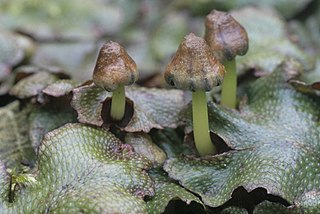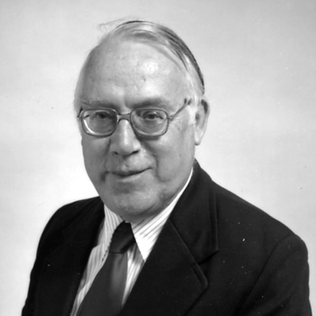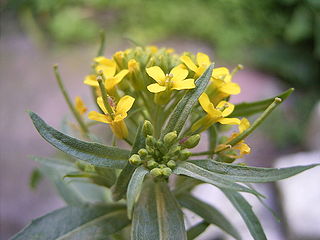
Phytoalexins are antimicrobial substances, some of which are antioxidative as well. They are defined, not by their having any particular chemical structure or character, but by the fact that they are defensively synthesized de novo by plants that produce the compounds rapidly at sites of pathogen infection. In general phytoalexins are broad spectrum inhibitors; they are chemically diverse, and different chemical classes of compounds are characteristic of particular plant taxa. Phytoalexins tend to fall into several chemical classes, including terpenoids, glycosteroids and alkaloids, however the term applies to any phytochemicals that are induced by microbial infection.

Naringenin is a flavorless, colorless flavanone, a type of flavonoid. It is the predominant flavanone in grapefruit, and is found in a variety of fruits and herbs.

Rutin, also called rutoside, quercetin-3-O-rutinoside and sophorin, is the glycoside combining the flavonol quercetin and the disaccharide rutinose. It is a flavonoid found in a wide variety of plants, including citrus.

Xanthone is an organic compound with the molecular formula O[C6H4]2CO. It is a white solid.

Conocephalum is a genus of complex thalloid liverworts in the order Marchantiales and is the only extant genus in the family Conocephalaceae. Some species of Conocephalum are assigned to the Conocephalum conicum complex, which includes several cryptic species. Conocephalum species are large liverworts with distinct patterns on the upper thallus, giving the appearance of snakeskin. The species Conocephalum conicum is named for its cone-shaped reproductive structures, called archegoniophores. Common names include snakeskin liverwort, great scented liverwort and cat-tongue liverwort.

Jeffrey Barry Harborne FRS was a British chemist who specialised in phytochemistry. He was Professor of Botany at the University of Reading, 1976–93, then Professor emeritus. He contributed to more than 40 books and 270 research papers and was a pioneer in ecological biochemistry, particularly in the complex chemical interactions between plants, microbes and insects.

Pinosylvin is an organic compound with the formula C6H5CH=CHC6H3(OH)2. A white solid, it is related to trans-stilbene, but with two hydroxy groups on one of the phenyl substituents. It is very soluble in many organic solvents, such as acetone.

Erysimum cheiranthoides, the treacle-mustard,wormseed wallflower, or wormseed mustard is a species of Erysimum native to most of central and northern Europe and northern and central Asia. Like other Erysimum species, E. cheiranthoides accumulates two major classes of defensive chemicals, glucosinolates and cardiac glycosides.

Tetrandrine, a bis-benzylisoquinoline alkaloid, is a calcium channel blocker. It is isolated from the plant Stephania tetrandra, and other Chinese and Japanese herbs.

Ononin is an isoflavone glycoside, the 7-O-β-D-glucopyranoside of formononetin, which in turn is the 4'-O-methoxy derivative of the parent isoflavone daidzein.

Europinidin (Eu) is an O-methylated anthocyanidin. It is a water-soluble, bluish red plant dye. It is a rare O-methylated flavonoid, a derivative of delphinidin. It can be found in some species of Plumbago and Ceratostigma.
The O-methylated flavonoids or methoxyflavonoids are flavonoids with methylations on hydroxyl groups. O-methylation has an effect on the solubility of flavonoids.

Prenylated flavonoids or prenylflavonoids are a sub-class of flavonoids. They are widely distributed throughout the plant kingdom. Some are known to have phytoestrogenic or antioxidant properties. They are given in the list of adaptogens in herbalism. Chemically they have a prenyl group attached to their flavonoid backbone. It is usually assumed that the addition of hydrophobic prenyl groups facilitate attachment to cell membranes. Prenylation may increase the potential activity of its original flavonoid.

Amentoflavone is a biflavonoid constituent of a number of plants including Ginkgo biloba, Chamaecyparis obtusa (hinoki), Biophytum sensitivum, Selaginella tamariscina, Hypericum perforatum and Xerophyta plicata.

In biochemistry, naturally occurring phenols are natural products containing at least one phenol functional group. Phenolic compounds are produced by plants and microorganisms. Organisms sometimes synthesize phenolic compounds in response to ecological pressures such as pathogen and insect attack, UV radiation and wounding. As they are present in food consumed in human diets and in plants used in traditional medicine of several cultures, their role in human health and disease is a subject of research. Some phenols are germicidal and are used in formulating disinfectants.
Flaveria chlorifolia, the clasping yellowtops, is a North American plant species of Flaveria within the family Asteraceae. It is native to the southwestern United States and northern Mexico.
A flavonoid alkaloid also known as a flavoalkaloid is a type of natural product produced by plants that contains both a flavonoid core structure and a nitrogen containing substituent so that the substance is also classified as an alkaloid. The most common flavonoid alkaloids contain a nitrogen heterocycle such as a pyridine or piperidine which is covalently bonded to the A-ring of a chromone. One flavonoid alkaloid, lilaline, was isolated from Lilium candidum in 1987. The synthesis of flavonoid alkaloids has been achieved

Dendrobium plicatile is an Asian orchid species, a member of the genus Dendobium. It was formerly described as Flickingeria fimbriata.

Anthochlor pigments are a group of secondary plant metabolites and with carotenoids and some flavonoids produce yellow flower colour. Both, chalcones and aurones are known as anthochlor pigments. Anthochlor pigments serve as UV nectar guides in some plants. Important anthochlor pigments accumulating plants are from the genus Coreopsis, Snapdragon or Bidens ferulifolia.
Solanesol is the organic compound with the formula Me2C=CHCH2(CH2C(Me)=CHCH2)8OH. It is an all trans stereoisomer. This white, waxy solid is classified as an nonaisoprenoid. Solanesol is a non-cyclic terpene alcohol that consists of nine isoprene units and mainly accumulates in solanaceous plants such as tobacco, potato, and tomato. It is extractable from the stems and leaves of solanaceous species. It is notable as the biosynthetic precursor to coenzyme Q10.
















